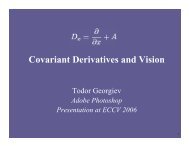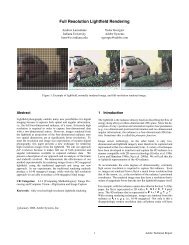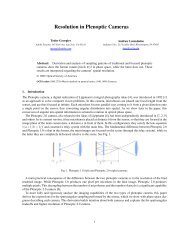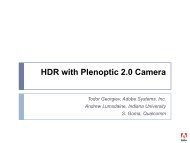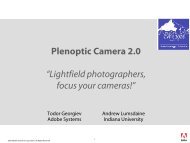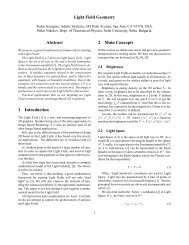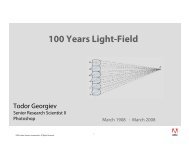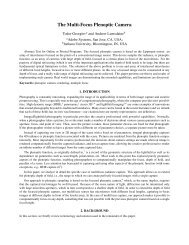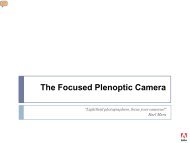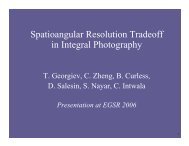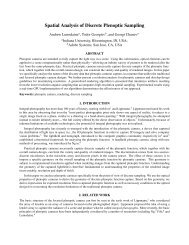Covariant Derivatives and Vision - Todor Georgiev
Covariant Derivatives and Vision - Todor Georgiev
Covariant Derivatives and Vision - Todor Georgiev
Create successful ePaper yourself
Turn your PDF publications into a flip-book with our unique Google optimized e-Paper software.
66 T. <strong>Georgiev</strong><br />
4 Test Case 2: Image Inpainting<br />
The method of Inpainting [2] works similar to solving the Laplace equation<br />
to reconstruct the selected area based on the boundaries. However, based on a<br />
higher order PDE related to fluid dynamics the method is able to partially reconstruct<br />
“structure” inside the inpainted area by continuation of the surrounding<br />
grayscale values into the inside. The behavior often resembles fluid flow <strong>and</strong><br />
sometimes is not exactly what we want. Later research attempts to also reconstruct<br />
the texture which is extracted from the surroundings using mathematical<br />
results from functional analysis [17].<br />
Figure 8 compares Inpainting (left) with “Structure <strong>and</strong> texture” Inpainting<br />
[17] (middle) <strong>and</strong> our new method of <strong>Covariant</strong> Inpainting. We would like to<br />
thank G. Sapiro <strong>and</strong> K. Patwardhan for producing the first two pictures. Our<br />
method is equivalent to replacing the derivatives in conventional Inpainting with<br />
covariant derivatives. As in the previous test case, the result is achieved in three<br />
steps. (1) Divide the original image by the texture image. (2) Solve the PDE, in<br />
this case the Inpainting PDE in the selected region. (3) Multiply by the texture<br />
image. We see that our result is better than both previous methods.<br />
Fig. 8. From left to right: Inpainting, Structure <strong>and</strong> texture inpainting, <strong>Covariant</strong><br />
inpainting<br />
5 Test Case 3: Gradient Domain High Dynamic Range<br />
Compression<br />
This section will be a theoretical derivation of previous results. As in previous<br />
sections, the value is in the new theoretical underst<strong>and</strong>ing <strong>and</strong> in showing that<br />
our approach has a wide area of applicability. We will be looking at the invariance<br />
properties of our fibre bundle approach in the case of relighting <strong>and</strong> adaptation<br />
to the new illumination of the scene.<br />
A central problem in dealing with high dynamic range images (HDR) is how<br />
to display them on a low dynamic range device, like a monitor. Just like scratch<br />
removal, the problem of HDR compression can be expressed in terms of relighting.<br />
As an example of how our method works, we will reproduce the results of<br />
one of the best approaches [5] starting from first principles.



